Built 1827, Improved 1830s Designated PHMC May 25, 1971 Added to NRHP 3 June 1976 | NRHP Reference # 76001616 Area 19 ha | |
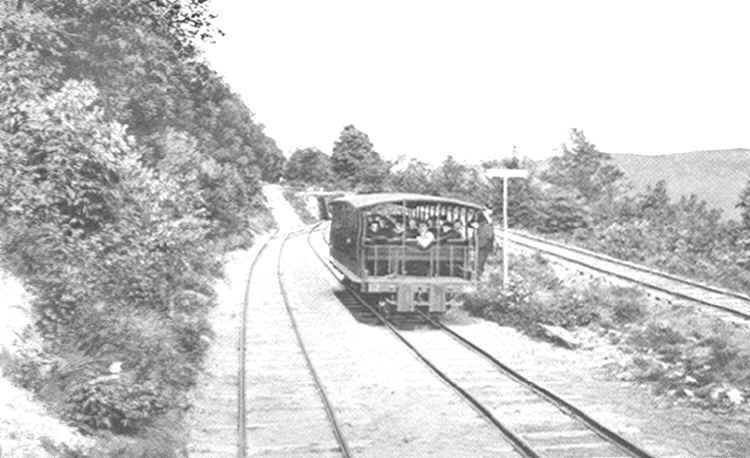 | ||
Location Built by Lehigh Coal & Navigation Co. (LC&N) | ||
The first operational US railway of any substantial length to carry paying passengers, 3 ft 6 in (1,067 mm) narrow-gauge Mauch Chunk Railroad, Summit Hill & Mauch Chunk Railroad, or Mauch Chunk & Summit Hill Railway, and later from 1872 into 1933 as the independent Mauch Chunk Switchback Railway, was built in 1827 by the Lehigh Coal & Navigation Company (LC&N) on top of their 9 miles (14 km)-constant-descent-graded wagon road and would run for over a hundred years until the middle days of the Great Depression. Given the prominence attained as a tourism destination by Mauch Chunk, and its weighty eminence as the corporate headquarters and political center of Carbon County amongst the picturesque landscaptes of the "Switzerland of America", the name Mauch Chunk Railroad where it met the lower Lehigh Canal main terminus was both technically correct (legally recognized) and most often used by publications over the first five decades of its operation as a primary coal road. It later also added 'Switchback' as a modifier when mining shifted to Lansford and Coaldale in the Panther Creek Valley, which adjective was retained as by the 1870s it was America's second most famous tourism destination after Niagara Falls, seeing an average 35,000 riders a year.
Contents

Pennsylvania's first railroad and first anthracite carrier opened on Saturday, May 5th, 1827, when seven cars of coal passed from the Summit Hill mines of the L.C.&N. Company to their canal at Mauch Chunk, descending 936 feet in the nine-mile trip.
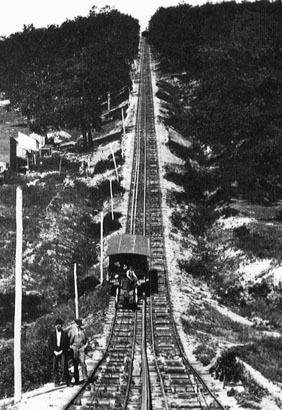
It was the second operational (permanent) United States railroad, the first over five miles long, and like the better known contemporary, B&O Railroad, it began using humble animal power to draw its consists—the mules were sent down in the last batch of cars and the return trip required 4-5 hours. It was part of what is credited by economists as the first American company to utilize vertical integration—providing raw materials, shipping, processing and final goods. In its last five decades of operation, shortly after the opening of the Hauto Tunnel in 1872, it was converted to primarily be (continue) as a tourist attraction and common mixed services carrier used by commuting locals, the postal service and for general freight.

The area had been given a rough survey by Josiah White and Hazard around 1815 when they initially contemplated leasing the rights of the Lehigh Coal Mine Company. Determining the river could be improved, the coal mined effectively, and they'd schemed out a means it could be shipped to the river, the two moved to obtain the rights, began soliciting investors, and lobbying the legislature for rights to improve the Lehigh River. Before spring of 1818, allowed construction of the Lehigh Canal as their rights were granted, the descending path of the 9 miles (14 km) route-to-be was surveyed by White and construction of mining facilities (1818-1819) and the modest beginning as a mule trail managed by Erskine Hazard as the two industry giants struggled to bring coal to energy-starved Philadelphia. In spring 1827, during a mere week—so well organized was their preparation, sleepers and rails were laid down on this path, which was already graded mild enough that brakemen only had to check the trains' speed over the sometimes swooping descents and speed reducing ascents.
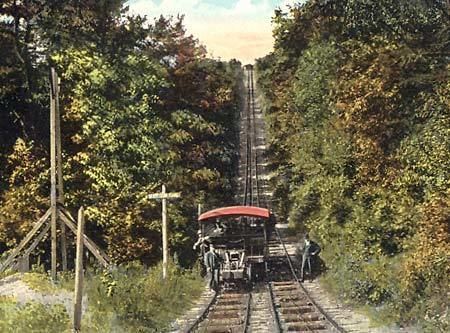
Thus began its period as a one-way gravity railroad that connected the coal which could be mustered at the peak of the Summit Hill shipping facilities athwart the ridge and Mauch Chunk (now Jim Thorpe) thus serving the shipping needs of one of the earliest commercial anthracite (coal) mines in Pennsylvania. With freight and passenger services, the early road required mules to return its four-ton coal cars to the top, which took over four hours; and the up trips carried other cargo as goods were needed as Summit Hill grew from a mine into a collection of mine heads, town, and services. Subsequently, the road would send down groups of 6–8 coal cars under control of a brakeman, and once 40–42 cars were down, send down the special "mule cars" with the draft animals, thus having just enough animals to return all cars back to the top. The road gradually became a popular sensation—a holiday travel destination for the well to do to visit and soon, with the earliest for-pay riders documented in 1829, began to carry passengers some of the time over the somewhat exciting descent. This gives rise to the credit of the railway as the first roller coaster.
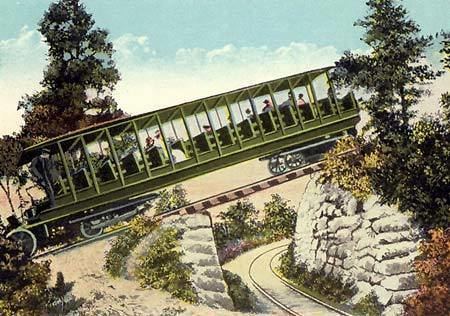
Anthracite product demand from the Lehigh Coal Company had grown steadily from 1820 when Lehigh Navigation Company had success getting the Lehigh Canal working well enough to deliver 365 long tons (371 t) to docks in Easton, Pennsylvania by year's end (and four years earlier than promised in stock prospectus circulars). Eventually, as a coal road, the return-by-mule railway could not keep up with throughput demands even operating three shifts, so despite some difficult engineering, the railroad was mutated to incorporate a new cable railway return loop in 1846 so became a combined gravity-incline plane combination railway with two steep cable railroad lift sections. A powered double-incline plane road led up to the top of two separate summits along Pisgah Ridge on the return leg (See "up track" on the map at right) and each summit had "a new down track" returning the cars several miles farther west in each case. This saw-tooth elevation profile gave the new return track a swooping characteristic ride later deliberately designed into roller coasters. About the same time, when other mine heads were opened in lower elevations of the Panther Creek Valley LC&N added several descending switchback sections and other shorter cable railway climbing inclines to bring the coal up from the new Lansford and Coaldale mines to the Summit Hill loading area for the gravity railway trip down to Mauch Chunk, thence to the Lehigh Canal (and in 1855, by rail transport) and their clamoring customers. The railroad became an early American tourist attraction and is considered as the world's first roller coaster, a role it would keep and satisfy with tourists for over five decades after it was abandoned as a primary freight railroad.
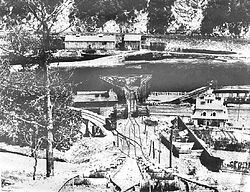
Background
Lehigh Coal Mining Company (LCMC) (1792-1822) had acquired lands around Summit Hill in 1792, a year after coal was discovered near the peak called 'Sharpe Mountain' along Pisgah Ridge. Transportation of bulk goods was a difficult problem as the United States did not have many developed roadways or waterways. The nearby Lehigh & Susquehanna Turnpike for example was an Amerindian trail improved and widened by a corporation and at best a mule train and bridle trail surmounting both the Broad Mountain and Nescopeck Mountain barrier ridges in Pennsylvania. LCMC would hire a crew to mine and bag coal, then log and construct one-trip coal arks at nearby Lausanne Landing, but had only sporadic success getting coal to industrialists in the Allentown-Philadelphia markets. They'd start by mule training the coal down the Mauch Chunk Creek valley to the Lehigh at one of several points near its mouth or by crossing south to the next valley over the Mauch Chunk Ridge at the Mahoning Hills to the Lehigh River near Lehighton. Those two difficulties overcome, the LCMC then had to deal with the Lehigh's variable waters and rapids so would often have many loads run afoul of river rapids and sink. In their last year-long expedition, exactly one of five arks reached the docks at Philadelphia, that one being bought by Josiah White and partner Erskine Hazard, who soon bought an option to the LCMC's operating rights. The ineptitude of the hands-off absentee owners of the LCMC leading to an inability to make reliable regular coal deliveries industrialists could count on would prove to be a historic turning point.
Services being unreliable, in 1818 inspired by the media coverage about the Erie Canal (begun 1817) and fed up with LCMC's delivery reliability, industrialists interested in securing a reliable coal supply bought the operating rights (leased) the company, and shortly after secured other investors forming as well the Lehigh Navigation Company, resolved to apply the high tech of the Canal Era (canals, locks, rails) to bringing coal to their foundries and the stoves and furnaces of Philadelphia and beyond. The mule roads used by the former management were quickly improved or replaced after a systematic survey, and work began nearly as rapidly on channels, locks and dams to tame the rocky Lehigh River with a canal. Late in 1820, four years ahead of promises to investors, the LNC delivered over 360 tons of Anthracite to Philadelphia, saturating the market until late that spring.
By mid-1821 the coal produced by new mining management was regularly and reliably servicing a growing customer base, but was still reliant on pack mule transport over the 9 miles (14 km) haul from Summit Hill to the coal chutes installed along the bench above Mauch Chunk, the town that became today's Jim Thorpe In 1822 the two companies were merged, and by 1824 the improvements along the pack mule trail, in the mines, and especially because of the Navigations of the Lehigh Canal (the company had built between 1818-1823); coal was flowing out of the company's mines around Summit Hill and the Lehigh Coal & Navigation Company's Lehigh Canal was regularly increasing amounts of coal shipped to the Delaware Riverport of Easton. Tardily, Pennsylvania built the Delaware Canal to connect the Lehigh, through which LC&N Co. also fed prodigious amounts of coal to the industries that sprouted up along its 60-mile length to Bristol, Pennsylvania.
Having had an eye for high-tech from the outset, the LC&N company's founders decided to try some of the railroad solutions put into place in England around Coalbrookdale, which birthed not only railroads, but both the steam locomotive, and the fixed cable winch engines which were used in many steep grades as well as for mining hoists.
In the early 1840s, control of the Summit Hill & Mauch Chunk Railroad Company was assigned to the Lehigh & Susquehanna Railroad (LH&S), a wholly owned transportation subsidiary of the Lehigh Coal & Navigation Company (LC&N Co.). The LH&S eventually became part of the storied Central Railroad of New Jersey (CNJ) when the LC&N Co. leased all of its railroad holdings to the CNJ, part of whose traffic, was tourists visiting from Philadelphia to ride the novel and exciting ramshackle gravity railroad with its scenic mountain ridge view.
Given permission by LC&N & LH&S boards of directors in the mid-1870s, the CNJ (operating company) later sold the tourist attraction to the newly formed 'Mauch Chunk, Summit Hill Switch-Back Railway Company', after the 1871 opening of the mile-long Hauto Tunnel eliminated the need to still operate the line as a coal road. After abandoning freight and commuter operations entirely in 1933, the railroad survived until 1938, continuing to opening weekends as an early roller coaster — just as it had on Sundays in 1829 — but with out the four hour up trip by mule cars.
History
The Mauch Chunk Rail Road was built and owned by the Lehigh Coal & Navigation Company. Construction began in January 1827 on an existing road and the road opened on May 5, 1827. It sent anthracite from company mines up at Summit Hill to the company's coal chutes in Mauch Chunk on the Lehigh River. The return trip was handled by mules, who then rode the trains downhill. Downhill cars covered the trip in 30 minutes, while the uphill trip took four hours. The trains were sometimes up to fourteen cars long, hauling 25 short tons (23,000 kg) of anthracite. The railroad was only the second in the United States (and the first coal road), and it was scenic and exciting to ride downhill, so it became a tourist attraction, and started occasionally carrying passengers. Soon, coal would only be handled in the morning, with passenger service taking over the afternoon. This recreational use gained importance, and became the sole purpose of the railroad. It inspired the development of the roller coaster. Some famous personalities who visited the railroad include Prince Maximilian of Wied, President Ulysses S. Grant, William Astor (son of John Jacob Astor), and Thomas Edison.
In 1846, the railroad responded to increasing demand for coal and the poor logistics of a single-track route by building a new up track consisting of two steam-powered, Josiah White engineered 120 horsepower (89 kW) funicular systems to replace the use of mules. These 'Planes' (incline planes) used two clever telescoping wheeled 'Barney' pusher cars attached to the cables by springy steel tow-bands running between two large diameter winch wheels located in the barney tunnels. When a car was readied for an assent, it was drifted down the slight incline from above and behind the barney tunnel to wait at a latch. The barneys came up and coupled behind to always push the consists up the hill. One of the inclines rose 664 feet (202 m) up Mount Pisgah, and the other crossed Mount Jefferson. The downhill trip continued to be powered by gravity, as did the downhill portions of the otherwise uphill direction. The up track was equipped with a ratchet which would prevent a car that detached from the cable from running away down hill. This invention later evolved into the anti-rollback device used on roller coasters. This was also when the railroad extended its name to the Mauch Chunk, Summit Hill and Switchback Railroad. The modernization of the railroad reduced a passenger round-trip from 4.5 hours to just 80 minutes.
In 1872, the Panther Creek Railroad opened as a replacement for the switchback line. The Central Railroad of New Jersey (CNJ) purchased it in 1874 and leased it to brothers Theodore and H. L. Mumford who operated the line as a tourist attraction. On May 24, 1929, the CNJ sold the line to the new Mauch Chunk Switchback Railway Company, which operated until 1932, when the line fell victim to the Great Depression. The mortgage on the property foreclosed and it was sold to scrapper Isaac Weiner for $18,000 (equal to $315,966 today).
In 1976, a 47-acre (19 ha) section of the former right-of-way, from Ludlow St. in Summit Hill to F.A.P. 209 in Jim Thorpe, was listed on the National Register of Historic Places as "Mauch Chunk and Summit Hill Switchback Railroad". The listed area included four contributing sites.
The right-of-way is now the Switchback Railroad Trail, but efforts are underway to rebuild the Mt. Pisgah incline portion of the route.
